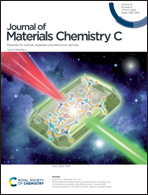Novel ultra-high-temperature zero-thermal quenching plant-protecting type blue-green dual-emission KAl11O17:Eu2+,Mn2+ phosphors for urban ecological lighting†
Abstract
Urban vegetation is an important stabilizer of urban ecological balance. The current urban lighting system destroys the growing habits of plants and causes the regression of urban vegetation groups owing to the redundant blue light, which also leads to huge economic losses. To solve this problem, novel plant-protecting type blue-green dual-emission phosphors KAl11O17:Eu2+,Mn2+ (KAlO:Eu2+,Mn2+), meeting the lighting requirements of plants, are reported. Compared to commercial phosphors, the blue light in our phosphor is greatly reduced through an energy transfer pathway that is far below the plant absorption curve. In addition, white LED devices fabricated with KAl11O17:Eu2+,Mn2+ phosphors show an excellent white emission with CIE coordinates of (0.324, 0.336). Moreover, thanks to its intrinsic defect energy level, this material achieves zero-thermal quenching above 295 °C. The superior photoluminescent properties endow this novel phosphor with bright potential to be applied as a white light source in urban ecological lighting systems in the future.



 Please wait while we load your content...
Please wait while we load your content...